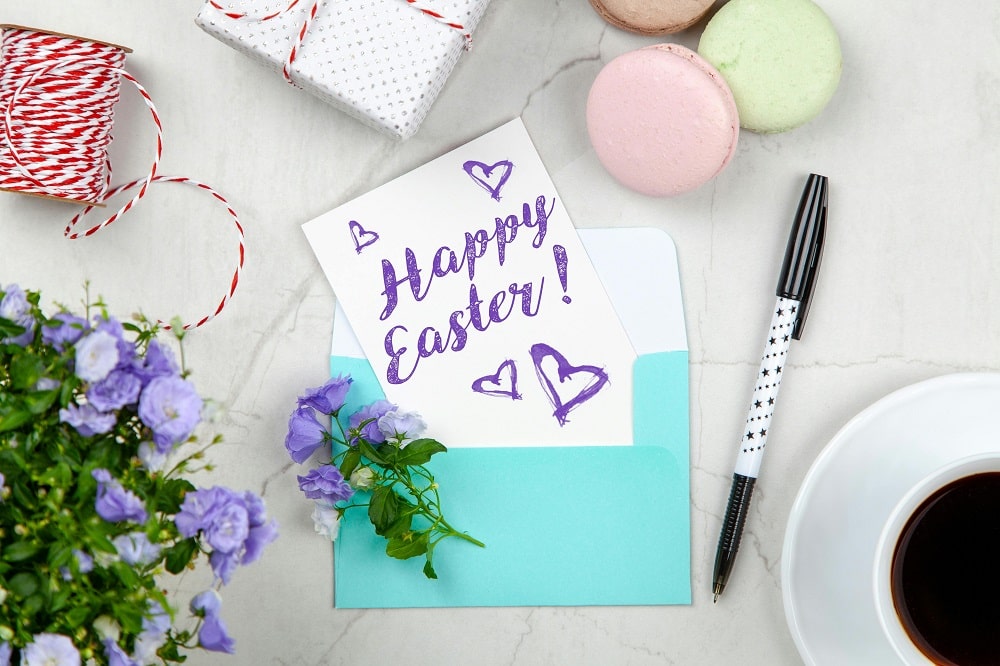
6 Fun Easter ESL Activities
With the right activities planned, you can take the opportunity to teach English through Easter in a way that’s fun and interactive.
Keep reading to learn about six fun activities you can use in an Easter-themed ESL lesson.
Contents
- 1. Paint Easter Eggs (with a Bonus English Lesson)
- 2. Have an “Everyday English” Easter Egg Hunt
- 3. Create an Easter Lunch Menu
- 4. Write Easter Poems
- 5. Compare Easter Customs and Traditions
- 6. Teach the History of Easter from the Bible
Download: This blog post is available as a convenient and portable PDF that you can take anywhere. Click here to get a copy. (Download)
1. Paint Easter Eggs (with a Bonus English Lesson)
Having your students paint Easter eggs is a great way to teach them about how Easter is celebrated in English-speaking countries. While this activity is perfect for children, it can be used for students of all ages and skill levels provided you teach people who you think would benefit from a hands-on learning experience.
To turn this fun activity into an effective ESL activity, you can introduce it with some English learning. Start the lesson off with an explanation on how children celebrate Easter by painting eggs and eating chocolate.
If you’re teaching lower-level students, try introducing Easter flashcards and teaching basic Easter-related vocabulary before you start painting eggs.
Students in the intermediate to advanced range should already have a good understanding of Easter vocabulary, so you may want to have them read “The Story of Easter and Easter Eggs” by the popular confectionery company Cadbury. This’ll help students practice their reading skills and it’ll give you the opportunity to access their comprehension by coming up with questions related to the story for them to answer. Some example questions include:
- When did people start making chocolate Easter eggs?
- Why is the egg important to Easter?
- How did people used to decorate Easter eggs?
Once you’ve used the above materials to explain a little bit about Easter traditions and painting eggs while getting in some English practice, show your class some examples of decorated and painted Easter eggs and then have them paint some Easter eggs of their own.
And if you’re unable to come across enough supplies like eggs, brushes and paint for the entire class, print some Easter egg coloring pages instead.
2. Have an “Everyday English” Easter Egg Hunt
Going on Easter egg hunts isn’t just an essential part of celebrating Easter, it’s also a great way to have fun with your students while giving them the opportunity to practice their English.
All you need to do is print out or draw a series of pictures relating to Easter and everyday life, and stick them inside plastic Easter eggs. Then, hide the eggs in the classroom or around the school and have your students search for them.
Your students will then take the pictures from the eggs and use them to come up with a written story in English.
For example, if someone finds three eggs with pictures of the Easter bunny, a basket and chocolate, they can write a story about receiving candy from the Easter bunny—or anything else, as long as it relates somehow to those three pictures.
This activity is great because it gives students the opportunity to practice their writing skills, while letting them use their own creativity and existing English knowledge to come up with an Easter-themed story.
If you’re teaching English to a large class of students, you might want to create teams of three to four students and limit each team to a maximum of three eggs. That way, every team gets an equal opportunity to participate.
3. Create an Easter Lunch Menu
As with most holidays we celebrate, Easter is a time when many people get together with loved ones and share a special lunch or dinner. For this reason, what better way is there to teach about Easter celebrations than to have your students design their own Easter menu?
This activity will help your class learn a little more about how Easter is celebrated in English-speaking countries, while giving them the opportunity to practice their writing skills and learn a bit more about food-related vocabulary.
Before you start the activity, make sure to explain a little bit about how some families celebrate Easter—or how you and your family celebrate Easter, if you do—and teach about some of the foods quintessential to Easter lunch and dinner.
While these foods vary depending on where you’re from, common Easter foods include:
- Hot cross buns.
- Chocolate eggs.
- Roasted leg of lamb.
- Roasted chicken.
You can even show your students some popular Easter recipes in the United States and in the United Kingdom to help them get an idea of what to put on their menu.
Print out pictures of various types of Easter foods and show them to your students, explaining a little bit about each food and whether it’s eaten in the United States, United Kingdom or elsewhere.
After introducing your food vocabulary, place your students into groups of three or four and have them come up with an Easter menu of their own.
Make sure to have them specify whether it’s for lunch or dinner, and have them give a short description of each dish that’ll be served. For example, next to hot cross buns, your students can write something along the lines of “sweet bread made with raisins and icing.”
Also, if you’re doing this activity with higher-level students, you can have them work together to come up with a recipe for an Easter food rather than a menu. That’ll require them to draw upon more advanced grammar knowledge and vocabulary, since they’ll be giving cooking instructions rather than describing types of food.
4. Write Easter Poems
Throughout history, countless authors writing in English have used Easter as an inspiration for some really incredible poems. If you’re teaching a class that’s already had some exposure to English literature, try introducing them to Easter poems. The website Famous Poets and Poems is home to many Easter poems written by British and American authors, including:
- “Easter, 1916” by William Butler Yeats.
- “Easter Morning” by Amy Clampitt.
- “Easter Day” by Oscar Wilde.
And after you and your students read over some poems, let your students take a stab at writing their own Easter poems.
But before you do, you might want to give your students a more specific topic to write their poem about—like Easter lunch or spending Easter with family. That’ll help them get an idea of what to write about and it’ll ensure that they stick to writing about Easter-related topics.
Also, don’t forget that activities involving poetry work best with students who’re between the upper-intermediate and advanced proficiency levels and have a good understanding of English and various nuanced words. Poetry isn’t as suited to beginners and students who’re learning how to have basic English conversations.
5. Compare Easter Customs and Traditions
This activity is suitable for all proficiency levels, but only really works with students who come from a country that celebrates Easter. For this reason, it probably won’t work as well with students from China, Japan, most of the Middle East, etc.
With that said, if you’re teaching a class in a country that tends to celebrate Easter, try giving a short explanation of the holiday and how it’s celebrated in English-speaking cultures.
Talk about things like Easter egg hunts, chocolate eggs and chocolate rabbits, eating a big meal with family and children waking up with Easter baskets filled with chocolate and candy.
After you explain a little bit about Easter, try quizzing your students by having them complete an Easter worksheet like one of these. Once they’re finished, have them give a short presentation about Easter in their countries, then compare and contrast the differences.
If you’re teaching a mixed classroom, this is a great individual activity. But if you’re teaching students who’re all from the same country, you might want to put them into pairs or groups of three and turn the presentation into a group activity.
6. Teach the History of Easter from the Bible
If you want to give an authentic representation of Easter as a religious holiday, try teaching the story from the Bible.
This works especially well if you’re teaching as part of a missionary or church program. But before you plan a lesson based on the Bible, it’s important that you be mindful of other cultures and beliefs. If your English lessons aren’t affiliated with a church or ministry, you should ask permission from your director or head teacher before planning a religious lesson.
If you’re able to teach an Easter lesson from a Christian point of view, talk with your students about Jesus, his crucifixion and his subsequent resurrection. Then, have students talk a little bit about what Good Friday and Easter mean to them from a Christian perspective.
A great worksheet for teaching Easter from a Biblical point of view is the Resurrection Questionnaire worksheet.
Before giving your students this hand-out, talk a little bit about Jesus, why he was persecuted and how he rose from the dead. After you go over the Easter story, let your students write the answers in the worksheet.
Finally, divide your class up into groups of three or four and have each group work together to come up with an Easter presentation on a topic of your choice.
Some great sample topics for your groups include:
- Why was Jesus crucified?
- What would happen to mankind if Jesus were not crucified?
- Why is it important that Jesus rose from the dead?
With the help of these activities, your students will remember Easter for more than just chocolate eggs and bunnies—they’ll also remember how much fun they had in the classroom.
When doing these activities, remember that it’s important to be mindful of your students’ religions and beliefs as well as the environment you’re teaching in.
Don’t focus on the religious side of the holiday unless you have permission from your school to do so, and if you’re teaching English in a country where the primary religion isn’t Christianity, don’t assume that you can teach Easter even as a secular holiday. Always ask your principal or head teacher beforehand.
Have fun teaching your students about Easter!
Download: This blog post is available as a convenient and portable PDF that you can take anywhere. Click here to get a copy. (Download)





